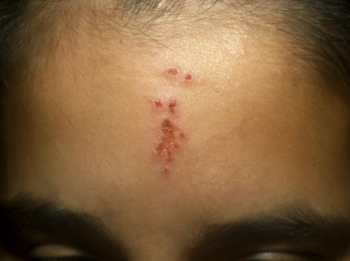
- Consultant for Pediatricians Vol 4 No 10
- Volume 4
- Issue 10
Photoclinic: Hooked Finger
A3-year-old boy was at home with his cousinwho was preparing for a fishing trip when afishhook accidentally became lodged in thedistal part of the child’s right middle finger(A).
A3-year-old boy was at home with his cousinwho was preparing for a fishing trip when afishhook accidentally became lodged in thedistal part of the child's right middle finger(A). There was mild erythema and swelling,with tenderness on palpation. No bleeding or dischargewas noted. The patient had full range of motion, withnormal sensation and capillary refill. Remaining examinationfindings were unremarkable. Radiographic viewsof the affected area confirmed the absence of bony infiltration(B).
The child was afebrile, active, alert, and in no apparentdistress. He had no significant medical history;his immunizations were up-to-date.
There are multiple approaches to dislodging a subcutaneousfishhook.1 Abu Khan,MD, and Mathew Ednick of Brooklyn,NY, emphasize that fishhook removalis unlike other foreign-bodyremoval because advancementthrough an alternative site is moresuccessful than removal through theinitial point of penetration.
The best way to extract abarbed fishhook is the "cut and advance"method:
- A wire cutter or trauma shear isused to sever the back end of thehook and shorten the overall length(C).
- After the affected area is anesthetizedand cleansed thoroughly, the fishhook is slowly advanced forward through a differentintact site in the skin. This method resulted in successfulremoval of the hook from the patient's finger (D).
The wound is cleaned with an alcohol swab, andtopical antibiotic lotion is applied. The finger is thenwrapped in sterile bandages.
When bone involvement is suspected, imagingstudies are needed to verify the hook's position before itis removed. When there is bone involvement, the hookis pulled back before it is advanced through the softtissue. Consider tetanus toxoid and prophylactic antibioticsin patients whose immunization status is unknownor not up-to-date.
References:
REFERENCE:
1.
Gammons MG, Jackson E. Fishhook removal.
Am Fam Physician
. 2001;63:2231-2236.
Articles in this issue
about 20 years ago
Carbon Monoxide Poisoning: Clues to Unmasking the Great Masqueraderabout 20 years ago
Pediatrics Update: Amblyopia Therapy Is for Older Children Tooabout 20 years ago
Tinea Faciei and Tinea Versicolorabout 20 years ago
What’s Wrong With This Picture? Child With Fever and Persistent Coughabout 20 years ago
Photoclinic: Plexiform Neurofibromaabout 20 years ago
Pediatrics Update: Avian Flu: Why All the Squawk?about 20 years ago
Photoclinic: Perianal Streptococcal Dermatitisabout 20 years ago
Photoclinic: Bohn Nodulesabout 20 years ago
Photoclinic: Congenital Melanocytic NevusNewsletter
Access practical, evidence-based guidance to support better care for our youngest patients. Join our email list for the latest clinical updates.









